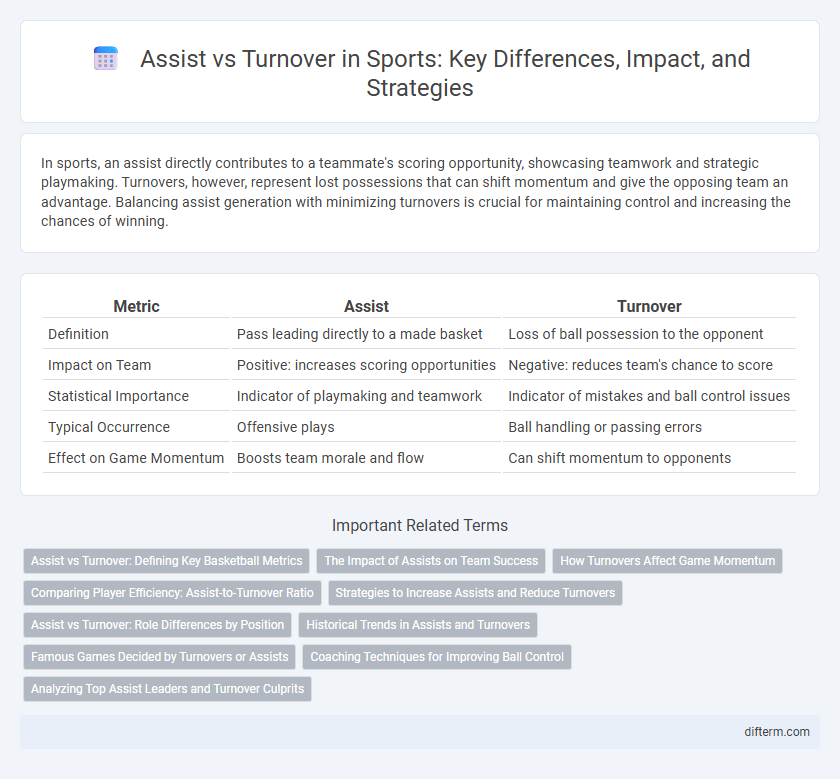In sports, an assist directly contributes to a teammate's scoring opportunity, showcasing teamwork and strategic playmaking. Turnovers, however, represent lost possessions that can shift momentum and give the opposing team an advantage. Balancing assist generation with minimizing turnovers is crucial for maintaining control and increasing the chances of winning.
Table of Comparison
| Metric | Assist | Turnover |
|---|---|---|
| Definition | Pass leading directly to a made basket | Loss of ball possession to the opponent |
| Impact on Team | Positive: increases scoring opportunities | Negative: reduces team's chance to score |
| Statistical Importance | Indicator of playmaking and teamwork | Indicator of mistakes and ball control issues |
| Typical Occurrence | Offensive plays | Ball handling or passing errors |
| Effect on Game Momentum | Boosts team morale and flow | Can shift momentum to opponents |
Assist vs Turnover: Defining Key Basketball Metrics
Assist vs turnover is a crucial metric in basketball that measures a player's playmaking efficiency by comparing the number of assists to turnovers committed. A high assist-to-turnover ratio indicates effective ball distribution and decision-making, contributing to team success. Coaches use this ratio to evaluate a player's ability to create scoring opportunities while minimizing mistakes on the court.
The Impact of Assists on Team Success
Assists significantly enhance team success by facilitating efficient ball movement and creating high-percentage scoring opportunities. Teams with higher assist-to-turnover ratios typically demonstrate better offensive efficiency and maintain greater control over the game's tempo. This positive correlation underscores the importance of playmaking and unselfish teamwork in achieving consistent victories.
How Turnovers Affect Game Momentum
Turnovers significantly shift game momentum by abruptly halting offensive drives and energizing the opposing team's transition opportunities. High turnover rates correlate with decreased scoring efficiency, often leading to defensive breakdowns and reduced team confidence. Teams that maintain assist-to-turnover ratios above 2.0 typically control possession better, minimizing momentum swings and increasing their chances of winning.
Comparing Player Efficiency: Assist-to-Turnover Ratio
The assist-to-turnover ratio is a critical metric in evaluating player efficiency, highlighting a player's ability to create scoring opportunities while minimizing mistakes. Players with a high assist-to-turnover ratio demonstrate superior decision-making and ball-handling skills, directly contributing to team success. This ratio offers coaches an analytical perspective to balance offensive productivity against turnover risk, crucial for strategic game planning.
Strategies to Increase Assists and Reduce Turnovers
Increasing assists while minimizing turnovers requires implementing effective passing drills and fostering on-court communication to enhance player synergy. Emphasizing decision-making under pressure during practice reduces risky passes, thus decreasing turnovers. Employing video analysis to review gameplay helps identify patterns, allowing coaches to tailor strategies that maximize assist opportunities and maintain ball control.
Assist vs Turnover: Role Differences by Position
Point guards typically record higher assist-to-turnover ratios due to their primary playmaking responsibilities, orchestrating offensive sets and facilitating teammate scoring opportunities. In contrast, shooting guards and small forwards often exhibit lower ratios as their roles emphasize scoring over distribution, leading to increased riskier passes and turnovers. Centers and power forwards generally show the lowest assist-to-turnover ratios, reflecting their focus on rebounds, screens, and inside scoring rather than ball handling and passing.
Historical Trends in Assists and Turnovers
Historical trends in basketball reveal a gradual increase in assists per game, reflecting improved team coordination and offensive strategies over decades. Conversely, turnovers have fluctuated, with peaks often linked to rule changes and shifts in playing pace that demand quicker decision-making. The assist-to-turnover ratio has become a key metric for evaluating player efficiency, emphasizing the evolution of playmaking skill and ball control in professional sports.
Famous Games Decided by Turnovers or Assists
In iconic sports moments, assists and turnovers have often been the pivotal factors deciding game outcomes, such as in the 2016 NBA Finals where LeBron James' clutch assist led to a critical basket, while the Golden State Warriors' costly turnovers shifted momentum irrevocably. In football, the 2019 Super Bowl saw key turnovers from the Los Angeles Rams that enabled the New England Patriots to control the clock and score crucial points. These instances highlight how strategic passing efficiency and ball security profoundly influence championship victories across sports disciplines.
Coaching Techniques for Improving Ball Control
Effective coaching techniques for improving ball control emphasize reducing turnovers while increasing assists to enhance team performance. Drills that focus on hand-eye coordination, decision-making under pressure, and precise passing can significantly lower turnover rates. Incorporating video analysis and real-time feedback enables players to understand mistakes and develop more accurate ball handling and distribution skills.
Analyzing Top Assist Leaders and Turnover Culprits
Top assist leaders demonstrate exceptional court vision and decision-making by consistently creating scoring opportunities, often averaging over 10 assists per game in elite leagues like the NBA. In contrast, turnover culprits exhibit lapses in ball control and judgment, with some players averaging upwards of 4 turnovers per game, impacting their team's offensive efficiency. Comparing assist-to-turnover ratios highlights players who maximize playmaking while minimizing mistakes, crucial metrics for evaluating overall offensive impact in professional basketball.
assist vs turnover Infographic

 difterm.com
difterm.com